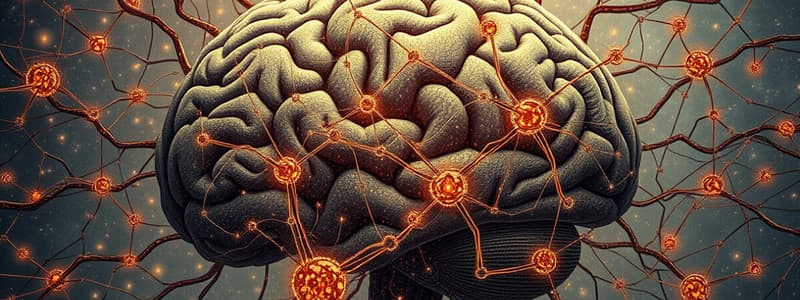Podcast
Questions and Answers
They do not learn themselves and are not adaptive, NO ______.
They do not learn themselves and are not adaptive, NO ______.
INTELLIGENCE
Classical Artificial Intelligence do not bring ______, we still need to program them.
Classical Artificial Intelligence do not bring ______, we still need to program them.
intelligence
We learn by ______ and make decisions in accordance with experience.
We learn by ______ and make decisions in accordance with experience.
experience
Neural Networks field of science is a multi-disciplinary subject including ______, Psychology, Maths, and more.
Neural Networks field of science is a multi-disciplinary subject including ______, Psychology, Maths, and more.
A formal neuron with a learning algorithm is called a ______.
A formal neuron with a learning algorithm is called a ______.
If y=+1 we say that the neuron is ______.
If y=+1 we say that the neuron is ______.
The basic unit in a neural network is called a ______.
The basic unit in a neural network is called a ______.
Parts of a formal neuron include N inputs, ______ for each input, and a weighted sum of inputs.
Parts of a formal neuron include N inputs, ______ for each input, and a weighted sum of inputs.
The weighted sum of inputs is expressed as y = w0x0 + w1x1 +...+ ______.
The weighted sum of inputs is expressed as y = w0x0 + w1x1 +...+ ______.
A threshold function returns 1 if y > 0, and ______ if y <= 0.
A threshold function returns 1 if y > 0, and ______ if y <= 0.
Study Notes
Neural Network Fundamentals
- Neurons communicate via electrical pulses known as action potentials or spikes, which signify firing.
- Input signals are received through dendrites, integrated, and converted into signals that travel along the axon.
- Axons connect with dendrites of other neurons, creating parallel communication pathways.
- Synapses are the electrical contact points between neurons.
Brain Architecture
- The cerebral cortex has differentiated areas identified by layer thickness and cell types.
- Key areas include:
- Motor Cortex: Areas 4 (motor strip), 6 (premotor), and 8 (frontal eye fields).
- Somatosensory Cortex: Areas 3, 1, and 2.
- Visual Cortex: Areas 17, 18, and 19.
- Auditory Cortex: Areas 41 and 42.
Neural Networks
- Artificial neural networks model human brain functions.
- Neuron count is generally fixed at birth, but connections change over a lifetime.
- Neural networks are mathematical adaptations derived from biological neural systems.
Applications and Research
- Widespread applications of artificial neural networks in problem-solving across various engineering disciplines.
- Significant presence in scientific research and publications related to neural networks.
Journals in Neural Networks Field
- Notable journals include:
- Neural Networks
- Neural Computation
- IEEE Transactions on Neural Networks
- Neurocomputing
- Journal of Computational Neuroscience
Objectives and Capabilities
- Aim to create systems that mimic human-like information processing capabilities.
- Current computers operate on strict algorithms and require programming to function.
- Human brains learn from experience and adapt without explicit programming.
Interdisciplinary Nature
- Neural networks intersect various fields:
- Neurobiology
- Psychology
- Mathematics
- Statistics
- Physics
- Computer Science
- Information Theory
- Electrical Engineering
Formal Neuron Structure
- A formal neuron has inputs, weights, and uses a weighted sum to determine output.
- Neuron fires (outputs +1) when the weighted sum surpasses a defined threshold; otherwise, it outputs -1.
- The basic unit of a neural network is defined by multiple inputs (x1 to xn), weights (w1 to wn), a weighted sum equation, and a threshold function.
Perceptron Concept
- A perceptron is a formal neuron equipped with a learning algorithm.
- Serves as a linear separator, fundamental in the function of neural networks.
Studying That Suits You
Use AI to generate personalized quizzes and flashcards to suit your learning preferences.
Related Documents
Description
Explore the intricate structure and functioning of both biological and artificial neural networks. This quiz covers essential concepts like neuron communication, brain areas, and the modeling of brain functions in artificial systems. Test your knowledge on the fascinating parallels between human brain architecture and neural networks!




